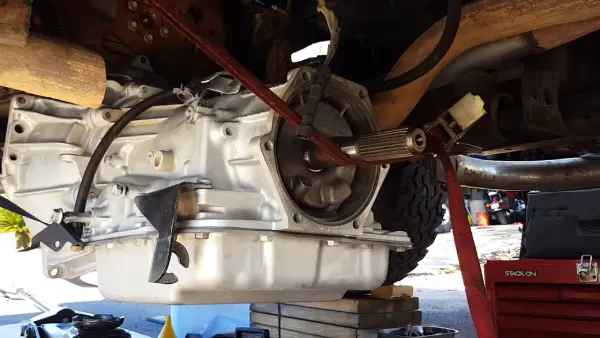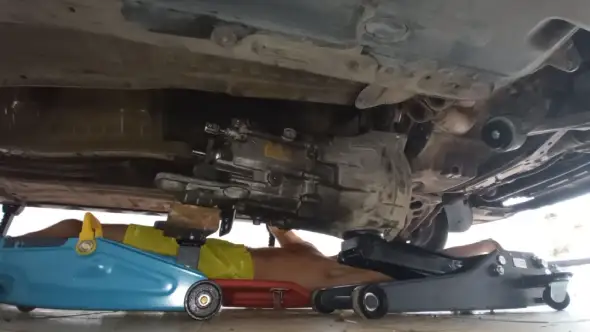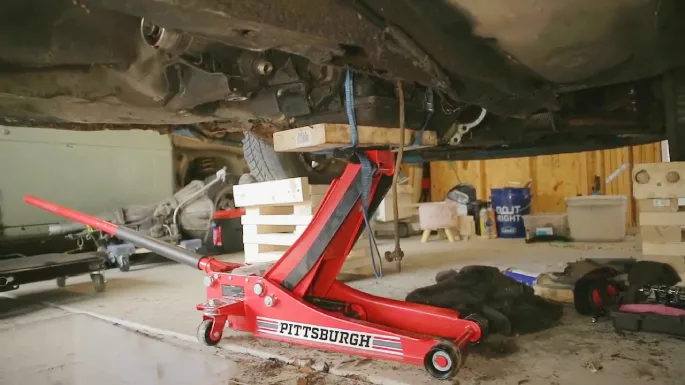Last Updated on May 7, 2023
For many auto enthusiasts, the thought of removing and replacing a transmission in their vehicle can be daunting. With specialized tools and expertise often required, tackling the job can feel intimidating.
While it is true that some removal methods can be tricky to execute safely, understanding why you shouldn’t use a floor jack as your go-to tool is essential. By utilizing alternative solutions, you can ensure that your vehicle and yourself are safe during the process.
Let’s take a look at how we can work together to properly remove transmissions without putting our cars unnecessarily at risk.
How Can You Drop A Transmission With A Floor Jack: Easy Steps

Before attempting to drop a transmission by utilizing a floor jack, prepare the vehicle properly. This will ensure a safe and efficient repair. Below, we will discuss the necessary steps for preparing the vehicle for the transmission removal process.
Prepare the Vehicle
- Raise the vehicle: Use a floor jack to raise the vehicle so that it is securely supported by jack stands.
- Locate the transmission: Identify the location of the transmission and the mounting bolts that hold it in place.
- Disconnect the battery: Disconnect the negative battery cable to prevent electrical hazards.
- Drain the transmission fluid: Drain the transmission fluid into a container, following the manufacturer’s guidelines.
- Remove any components in the way: Remove any components that may obstruct access to the transmission, such as the driveshaft, exhaust pipes, or shifter linkage.
- Gather necessary tools: Make sure you have all the necessary tools, such as a socket set, wrenches, and a floor jack, before starting the removal process.
After preparing the vehicle, the next step in raising a floor jack is to position the floor jack properly. The floor jack supports the transmission as it is removed from the vehicle. We will discuss how to position the floor jack in this section correctly.
Position the Floor Jack
- Place the jack under the transmission: Place the floor jack under the transmission, ensuring that it is positioned in the center of the transmission.
- Secure the jack: Secure the floor jack by tightening the bolts or locking mechanism on the jack.
- Raise the jack slightly: Raise the jack slightly so that it supports the weight of the transmission.
With the vehicle prepared and the floor jack properly positioned, it is time to drop the transmission. The removal of the transmission with a floor jack will be discussed here.
Dropping the Transmission
- Loosen the mounting bolts: Make use of a socket set, and loosen the bolts that secure the transmission in place.
- Lower the jack: Carefully lower the floor jack to allow the transmission to separate from the engine.
- Remove the transmission: With the bolts unbolted, lift the transmission off of the jack and remove it from the vehicle.
With the old transmission removed, it is time to install the replacement transmission. Here we will discuss installing a replacement transmission using a floor jack.
Installing the Replacement Transmission
- Place the replacement transmission on the floor jack: Position the floor jack under the replacement transmission and raise it until the transmission is supported by the jack.
- Align the transmission: Align the replacement transmission with the mounting points on the engine.
- Secure the transmission: Using the bolts that were removed from the old transmission, secure the replacement transmission in place.
- Raise the floor jack: Raise the floor jack until the transmission is properly positioned.
- Tighten the mounting bolts: Using a socket set, tighten the bolts that keep the transmission in place.
Alternative Methods to Drop a Transmission with a Floor Jack

Jack stands are a standard tool used in automotive repair and maintenance, including removing a transmission. They are simple and affordable, making them a popular alternative to floor jacks. We’ll examine how to disassemble a transmission using jack stands in this section.
Advantages of Using Jack Stands
- Stability: Jack stands are designed to provide stable support for a vehicle, which is essential when removing a transmission.
- Adjustability: Jack stands come in different heights, making it possible to find the right height for your vehicle.
- Portability: Jack stands are lightweight and small, so they can be easily transported.
Engine hoists, also known as engine cranes, are another alternative tool for removing a transmission. They are designed to lift heavy engine components, making them ideal for removing transmissions. The purpose of this section is to examine how to remove a transmission using engine hoists.
Advantages of Using Engine Hoists
- Lifting Capacity: Engine hoists have a high lifting capacity, making them suitable for removing transmissions from heavy vehicles.
- Ease of Use: Engine hoists have various features, such as adjustable arms, casters, and chains, making them easy to use.
- Versatility: Engine hoists can be used for various tasks, not just removing transmissions.
- Stability: The combination of a floor jack and engine hoist provides stable support for the vehicle, allowing for safe transmission removal.
For those who do not have the necessary tools or experience to remove a transmission on their own, a professional mechanic is a worthwhile alternative.
Professional mechanics have the knowledge, equipment, and experience to remove a transmission efficiently.
To demonstrate the benefits of using a professional mechanic rather than a jack to drop a transmission, we’ll look at this section in greater detail.
Advantages of Using Professional Mechanics
- Experience: Professional mechanics have the experience and knowledge to safely and efficiently remove a transmission.
- Equipment: Professional mechanics have access to specialized tools and equipment that make the job easier and more efficient.
- Safety: Professional mechanics follow proper hazard prevention measures and manufacturer’s guidelines to ensure a safe and effective repair.
- Time-Saving: Using a professional mechanic can save time and effort compared to removing the transmission.
What to Expect When Using Professional Mechanics
- Inspection: The professional mechanic will inspect the vehicle to determine the best method for removing the transmission.
- Quote: The mechanic will provide a quote for the repair, including the cost of removing the transmission and any necessary parts or components.
- Removal: The professional mechanic will remove the transmission, making sure to follow proper safety precautions and manufacturer’s guidelines.
- Installation: The mechanic will install the replacement transmission, ensuring it is properly installed and functional.
Removing a Transmission with Jack Stands, Engine Hoists, & Professional Mechanics

Regardless of whether you use jack stands, an engine hoist, or professional mechanics, there are specific steps that are common to the removal of a transmission. The steps for removing a transmission will be discussed in this section.
General Steps for Removing a Transmission
- Prepare the vehicle: Park the vehicle on a level surface and engage the parking brake. Remove any components that may be in the way of the transmission, such as the exhaust system.
- Support the engine: If using jack stands, place the stands under the vehicle and raise the vehicle to provide adequate clearance for the transmission. If using an engine hoist, attach the hoist to the engine.
- Loosen the mounting bolts: With a socket set, loosen the bolts that hold the transmission in place.
- Lower the engine: If necessary, use jack stands to lower the vehicle until the transmission separates. If using an engine hoist, lower the engine to allow the transmission to split.
- Remove the mounting bolts: Once the transmission has been lowered, remove the mounting bolts.
- Remove the transmission: Once the bolts have been removed, remove the transmission from the vehicle.
Can a Floor Jack Support the Weight of a Transmission?
When considering a floor jack, it is important to choose one with the capacity to support the weight of your vehicle. For most sedans and small cars, a two-ton jack will be sufficient for raising a corner.
To lift a transmission, you may need a heavier-duty 3 or 4-ton version. This is because transmissions can weigh anywhere from 80 to 300 pounds depending on the type and size of the vehicle. When lifting any part of your car, ensure that your floor jack is rated for at least three-quarters of your vehicle’s gross weight.
Some jacks have built-in safety features such as overload protection and bypass valves, which help prevent overloading and protect against damage. When selecting a floor jack, ensure that it has these features to ensure maximum safety while working on your car.
When choosing a floor jack for lifting transmissions or other parts of your car, ensure that it has the capacity and safety features necessary for the job. Consider the weight of your vehicle before purchasing so that you can select an appropriate model for the job.
What Are the Dangers of Using a Floor Jack to Lower a Transmission?

Point 01. Jack’s Failure
Using a floor jack to plunge a transmission comes with risk. The risk is the jack failing if it cannot withstand the weight of the transmission and its components. Improper maintenance or an older jack can contribute to this type of failure. Corrosion is another factor that may lead to this issue.
When this happens, there is no telling how much force will be exerted on the transmission. It could also fall, which could cause serious damage to the vehicle and physical injury to anyone in close proximity.
Point 02. Overloading
Another danger associated with using a floor jack is overloading. This can happen when dropping a transmission. If too much weight is applied to the jack when lowering the transmission, it can cause it to become unstable.
This can lead to the jack collapsing, which can be extremely dangerous. Ensure that only enough weight is applied. Also that the jack remains stable and secure while operating.
Point 03. Unstable Positioning
A third potential trouble associated with using a hydraulic floor jack to drop a transmission is that it can cause instability inside the transmission itself. If improper positioning techniques are used during operation, this could lead to severe problems.
This includes positioning objects such as tools or equipment too close to where you’re trying to lower the transmission. This allows them to contact one another during operation, causing damage inside or outside the system.
Point 04. Lack of clearance
When operating a floor jack, it is essential to ensure that the area around the engine is clear. Objects and obstacles must be removed from the area before the transmission can be dropped.
If there isn’t enough clearance, the floor jack could cause serious damage. It could also damage other components and parts in the surrounding area.
Point 05. Improper use
Using a floor jack improperly can lead to serious injuries and even death. This is because, if used incorrectly, the jack could collapse or slip under pressure. Such incidents can have catastrophic and expensive results.
Follow all manufacturer instructions carefully when using a floor jack. Only qualified personnel should operate this equipment.
Point 06. Physical injury
Even when following all directions carefully, accidents involving a floor jack can still occur. Ensuring correct clearance is essential to avoid these accidents.
Personnel should always wear appropriate safety clothing when operating any lifting equipment. This could include safety goggles and heavy-duty gloves, such as a floor jack.
Not taking precautions can put operators at risk for physical injuries. Unexpected movements or unexpected collapses from defective jacks or incorrect operations can lead to these injuries.
Safely Remove Your Transmission: A Successful Repair
You can drop a transmission with a floor jack, but it requires careful preparation, proper positioning, and careful execution. Follow the manufacturer’s guidelines and safety precautions to ensure a safe and successful repair.
Alternative approaches, such as using jack stands and engine hoists, can be effective. They may have different advantages and disadvantages.
Suppose you’re uncomfortable removing a transmission on your own. In that case, a professional mechanic is a great choice. They have the experience, knowledge, and equipment to remove a transmission safely.
Regardless of your choice, make sure to take your time, follow the instructions, and take the necessary precautions to ensure a successful repair.
